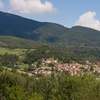Magliano
Magliano, located on the south side of Monte Tea, between the Aulella and Serchio di Soraggio rivers, is divided into two centres: "Magliano a mattino " and "Magliano a Sera ".
The Church of Sant’Andrea, in which the saintly bodies of the martyrs Giusto and Emiliano are preserved, dates back at least to 1297. The building was altered several times: in 1734 it was completely renovated and enriched with numerous works of art of exquisite workmanship, including an interesting neo-Gothic triptych depicting the Madonna and Child.
The Church of SS. Vincenzo and Anastasio, which houses the fifteenth century altarpiece by Bernardino del Castelletto depicting the Madonna and Child with Saints, is also worth a visit.
Historical notes
The first written record of the village dates back to 793, when Bishop Giovanni bought some properties in Magliano and Ponteccio.
During the Middle Ages, a fort was built near the village centre, the remains of which were recently found near the ruins of the church of Santa Felicita, a place of worship halfway between Castelletto and Magliano. The "castrum de Malliano cum pertinentiis" is in fact mentioned in 1185 in a diploma of Emperor Federico Barbarossa.
Possession of the fortifications and villages was entrusted to the nobles of Dalli. The members of this family, although they had sold all of their possessions to the city of Lucca in 1229, continued to reside for a long time in the lands which they had formerly dominated, while the community remained tied for centuries to the activities of pastoralism.
Following the fall of the government of Paolo Guinigi (1430), Magliano, like other villages in the area, remained for a few years under Florentine rule until, in 1446, when it decided to submit to the authority of the Marquis Lionello d'Este, escaping the ongoing disputes that counterposed Lucca and Florence.









